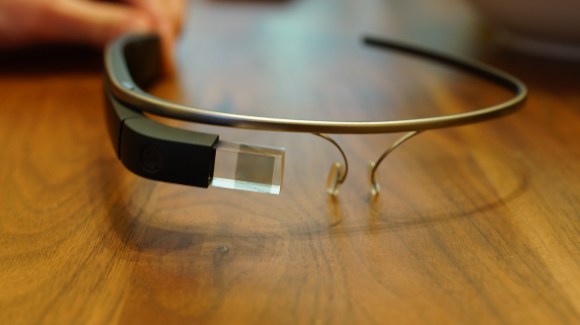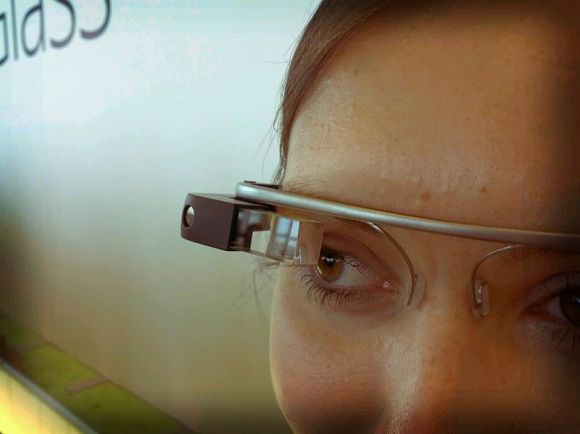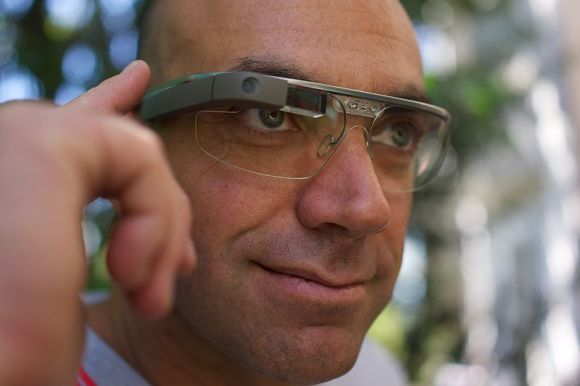
By now, you’ve surely heard about Google Glass, the head-mounted computer that allows the wearer to interact with data while going about their day thanks to a tiny display that hovers in the top-right corner of their vision. While this all sounds like a wonderful little slice of the future, the product has come under scrutiny recently amid privacy concerns raised by politicians, and many are wondering about the possible implications of using it in the real world.
While most reviews have been from the perspective of native English-speakers, today we stumbled upon an interesting review written by a Japanese speaker. Despite the country being considered by many to be the home of computer wizardry, Japanese people are often a little shy of new devices at first (the iPhone was positively ignored for its first year on the market), so we were keen to get a Japanese perspective.
Just a couple of paragraphs into the writeup, however, we noticed that the reviewer had stumbled upon a couple of minor problems with Google Glass.
Written by Tazunu Ishikawa for Weekly ASCII, the review starts with the basic Google Glass run down. You can connect Glass to the Internet via a smartphone or wi-fi; it’s got a touch panel on the side to control Glass with; it uses both voice commands and motion detection to navigate the interface, take photos, do searches, and respond to text messages. It all sounds great. But it was when trying to communicate with the device that Ishikawa had trouble.
▼A logo so simple, it can’t even be copyrighted, according to Wikipedia.
Since Google Glass is still in development (only 2,000 units have been shipped so far and all of them to app/software developers), it’s pretty much English only. As others have documented, there are certain English words that can be difficult for non-native speakers to pronounce. That said, voice recognition software doesn’t always correctly understand native speakers, so this isn’t just an issue for Japanese people.
Ishikawa pointed out another potential problem with Glass—they don’t fit well over real glasses. So, if you happen to need prescription spectacles, you’ll probably want to grab some contacts to use with the device. However, the reporter did mention that the screen was easy to see and had good definition, so at least your contacts will be worth the investment!
▼Nerd fashion is fashion!
In addition to taking pictures and recording videos (with consent only, please!!!), Glass is great for directions. If you can get the device to understand where you want to go. Ishikawa noted that he had some trouble getting the software to understand exactly what he was looking for. Finally, he settled on that old stand-by “Starbucks.” This really seems like a commercial waiting to be made, doesn’t it?
Another issue with language support came from social networks. Ishikawa notes that when attempting to display tweets in Japanese, Glass just threw up a bunch of question marks, suggesting that language packs have yet to be added. At least the basic functionality is there, right?
▼The most heroic-looking smartphone peripheral ever? We think so!
Overall, Weekly ASCII‘s reviewer seemed impressed with Glass. And, since it can interface with both Android phones and iPhones, searches can be culled and categorized to improve your advertising experience regardless of the smartphone you use.
We’re sure that Google will add better language support once they get closer to full production. So we can’t wait to see the results of Ishikawa vs Google’s voice recognition round two!
Source: Weekly ASCII
Images: Wikipedia




 Affordable glasses that help blind people understand text now receiving crowdfunding support
Affordable glasses that help blind people understand text now receiving crowdfunding support High-tech glasses provide near-instant translation of Japanese text
High-tech glasses provide near-instant translation of Japanese text New “Privacy Glasses” protect your identity and your image
New “Privacy Glasses” protect your identity and your image Now you can experience getting stopped by the Japanese police on Google Streetview
Now you can experience getting stopped by the Japanese police on Google Streetview NTT showcases technology which can “correct” Japanese people’s English pronunciation
NTT showcases technology which can “correct” Japanese people’s English pronunciation 7-Eleven Japan’s ramen-cooking robot whipped us up a bowl of noodles【Taste test】
7-Eleven Japan’s ramen-cooking robot whipped us up a bowl of noodles【Taste test】 Japan’s otoshidama tradition of giving kids money at New Year’s gets a social welfare upgrade
Japan’s otoshidama tradition of giving kids money at New Year’s gets a social welfare upgrade Can a dirty butthole make you filthy rich in Japan? We’re starting a New Year’s lottery experiment
Can a dirty butthole make you filthy rich in Japan? We’re starting a New Year’s lottery experiment Japan may add Japanese language proficiency, lifestyle classes to permanent foreign resident requirements
Japan may add Japanese language proficiency, lifestyle classes to permanent foreign resident requirements Hello Kitty Choco Egg figures are an adorable trip through three periods of Japanese pop culture【Pics】
Hello Kitty Choco Egg figures are an adorable trip through three periods of Japanese pop culture【Pics】 New smartphone game lets you date real-life J-pop idols, but shockingly gives them 100 Boyfriends
New smartphone game lets you date real-life J-pop idols, but shockingly gives them 100 Boyfriends More Than a Capsule Stay: Why Solo Travelers Choose “global cabin Yokohama Chinatown”
More Than a Capsule Stay: Why Solo Travelers Choose “global cabin Yokohama Chinatown” What the heck is okame soba?
What the heck is okame soba? Dragon Quest Burgers and Slime drinks are coming to McDonald’s Japan【Video】
Dragon Quest Burgers and Slime drinks are coming to McDonald’s Japan【Video】 Here’s what US$90 worth of katsu curry looks like at CoCo Ichibanya: A mountain of cutlets!
Here’s what US$90 worth of katsu curry looks like at CoCo Ichibanya: A mountain of cutlets! 7-Eleven Japan starts new temporary luggage storage service in over 300 branches
7-Eleven Japan starts new temporary luggage storage service in over 300 branches Disillusionment at Tsukiji’s tourist-target prices led us to a great ramen restaurant in Tokyo
Disillusionment at Tsukiji’s tourist-target prices led us to a great ramen restaurant in Tokyo Starbucks teams up with 166-year-old Kyoto doll maker for Year of the Horse decorations【Photos】
Starbucks teams up with 166-year-old Kyoto doll maker for Year of the Horse decorations【Photos】 Starbucks Japan releases new zodiac chilled cup drink for 2026
Starbucks Japan releases new zodiac chilled cup drink for 2026 Lacquerware supplier to emperor of Japan and Pokémon team up for new tableware
Lacquerware supplier to emperor of Japan and Pokémon team up for new tableware Tokyo’s Tsukiji sushi neighborhood asks tour groups to stay away for the rest of the month
Tokyo’s Tsukiji sushi neighborhood asks tour groups to stay away for the rest of the month Is this the most relaxing Starbucks in Japan?
Is this the most relaxing Starbucks in Japan? Starbucks on a Shinkansen bullet train platform: 6 tips for using the automated store in Japan
Starbucks on a Shinkansen bullet train platform: 6 tips for using the automated store in Japan Street Fighter Hadouken Churros to be launched and eaten in Tokyo, Okami pudding on offer too
Street Fighter Hadouken Churros to be launched and eaten in Tokyo, Okami pudding on offer too Japan’s human washing machines will go on sale to general public, demos to be held in Tokyo
Japan’s human washing machines will go on sale to general public, demos to be held in Tokyo Japanese train company is letting fans buy its actual ticket gates for their homes
Japanese train company is letting fans buy its actual ticket gates for their homes Tokyo considering law requiring more trash cans following litter increase in heavily touristed area
Tokyo considering law requiring more trash cans following litter increase in heavily touristed area Nintendo’s Kirby now delivering orders at Kura Sushi restaurants, but not in Japan
Nintendo’s Kirby now delivering orders at Kura Sushi restaurants, but not in Japan Tokyo event lets you travel back in time, for free, to celebrate 100 years since Showa era start
Tokyo event lets you travel back in time, for free, to celebrate 100 years since Showa era start Sanrio theme park in Japan announces plans to expand into a Sanrio resort
Sanrio theme park in Japan announces plans to expand into a Sanrio resort Survey asks foreign tourists what bothered them in Japan, more than half gave same answer
Survey asks foreign tourists what bothered them in Japan, more than half gave same answer Japan’s deadliest food claims more victims, but why do people keep eating it for New Year’s?
Japan’s deadliest food claims more victims, but why do people keep eating it for New Year’s? We deeply regret going into this tunnel on our walk in the mountains of Japan
We deeply regret going into this tunnel on our walk in the mountains of Japan Studio Ghibli releases Kodama forest spirits from Princess Mononoke to light up your home
Studio Ghibli releases Kodama forest spirits from Princess Mononoke to light up your home Major Japanese hotel chain says reservations via overseas booking sites may not be valid
Major Japanese hotel chain says reservations via overseas booking sites may not be valid Put sesame oil in your coffee? Japanese maker says it’s the best way to start your day【Taste test】
Put sesame oil in your coffee? Japanese maker says it’s the best way to start your day【Taste test】 The top 10 annoying foreign tourist behaviors on trains, as chosen by Japanese people【Survey】
The top 10 annoying foreign tourist behaviors on trains, as chosen by Japanese people【Survey】 No more using real katana for tourism activities, Japan’s National Police Agency says
No more using real katana for tourism activities, Japan’s National Police Agency says Starbucks Japan reveals new sakura drinkware collection, inspired by evening cherry blossoms
Starbucks Japan reveals new sakura drinkware collection, inspired by evening cherry blossoms Want to become a virtual YouTuber? Now there are apps for that too!
Want to become a virtual YouTuber? Now there are apps for that too! You can romance a pair of glasses in this new Japanese mobile dating sim
You can romance a pair of glasses in this new Japanese mobile dating sim Six outdoor Japanese hot springs you can visit right now (with Google Street View)
Six outdoor Japanese hot springs you can visit right now (with Google Street View) Google’s English translation for short Japanese phrase hints at huge, TV-series-length backstory
Google’s English translation for short Japanese phrase hints at huge, TV-series-length backstory Japanese art site Pixiv now lets you make your own 3-D model for free, and in English!
Japanese art site Pixiv now lets you make your own 3-D model for free, and in English! “3 bottles available” – Life’s Good when you can mail your fridge to ask if there’s any beer left
“3 bottles available” – Life’s Good when you can mail your fridge to ask if there’s any beer left English-learning smartphone app teaches Japanese students to say “I just took a dump”
English-learning smartphone app teaches Japanese students to say “I just took a dump”
Leave a Reply